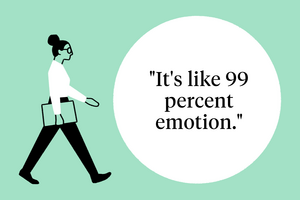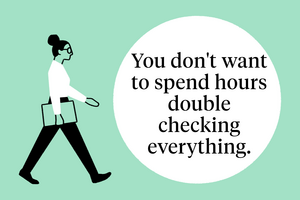It seems obvious: the closer you are to reaching a goal—losing 20 pounds, raising money in a fundraiser, or working toward a reward in a loyalty program—the higher your motivation.
Studies over the past seven decades have found support for this idea. But two Kellogg School researchers, in collaboration with an Italian colleague, have cast doubt on it. Motivation, they hypothesize, might in fact decrease about halfway through pursuit of a specific goal, only to increase as the goal comes closer.
The researchers—Miguel Brendl, an associate professor of marketing at the Kellogg School of Management; Andrea Bonezzi, a former PhD student at the Kellogg School; and Matteo De Angelis, an adjunct professor of marketing at LUISS Guido Carli University in Italy—proposed a “psychophysical model of goal pursuit” that accounts for the tendency to get “stuck in the middle.”
“What we’re saying is that the perception of the next steps toward a goal is different depending on how close we are to the goal,” Brendl says. “There’s a perceptual element in how we get motivated.” When we perceive that our efforts will yield good progress, we feel more motivated, he points out. But when we feel like our efforts will yield little progress, our motivation wanes. Our perception of progress depends on how we measure it. Do we look to how far we have to go? Or how much we have already accomplished?
The idea that motivation increases with proximity to a particular goal features in an old saw of the equestrian world: that “horses run faster when they approach the stable,” as Brendl explains. “That may or may not be true,” he adds, “but it emphasizes the importance of a point of reference in determining the level of motivation.”
The idea that motivation increases with proximity to a particular goal features in an old saw of the equestrian world: that “horses run faster when they approach the stable,” as Brendl explains.
Typically, any goal-oriented undertaking can involve two reference points: the beginning and the end. Take a summer reading assignment. A student striving to finish the assignment will regard reading one more page as more important when just 50 pages remain than when there are 200 pages to go.
For that individual, motivation will increase as the distance from completing the assignment decreases. But a student who measures progress in terms of the distance from the beginning of the assignment will take a different view. In this case, reading one more page will seem to yield less progress after having read 200 pages than after having read 50 pages.
“We suggest that people tend to adopt their initial state as the reference point at the beginning of goal pursuit and the desired end state as their reference point when nearing the goal,” the researchers write. “This is because the initial state is more salient at the beginning of goal pursuit, whereas the desired end state is more salient toward the end of goal pursuit.”
The Shift
It is the “attentional shift” from the initial to the final state of the endeavor that causes the level of motivation to reach its nadir roughly halfway toward the goal, when both the initial state and the end state seem distant.
“We showed that participants exhibited a tendency to focus on the initial state as the standard of reference at the beginning of goal pursuit, but then shifted their focus to the desired end state as the end neared. The observed stuck-in-the-middle pattern resulted from this switch in reference points,” the researchers write.
“Our findings point to a previously undiscovered vulnerability occurring about halfway to a goal,” Bonezzi says. “When we try to achieve goals, the difficulty often comes in the middle and the risk is that in some cases, we might give up at this stage, thus literally getting ‘stuck in the middle.”
Brendl and his colleagues probed the nature of the vulnerability by running three experiments. The first gave volunteers the chance to earn money by creating as many words as possible from the letters in a series of nine words presented in random order. The data suggested that respondents exerted less effort halfway through the process than closer to the beginning or end.
The second experiment aimed to check whether mental fatigue might have caused the lack of effort. The team gave the participants $15 and selected details about fundraising by a charity to which they were told to donate some of the cash. Respondents informed that the charity was close to its goal donated more than those told that fundraising was just starting or was halfway to the goal. But participants informed only how much the charity had already collected behaved differently. They donated more when informed that the collection was just starting than when it was in the middle or near the end.
The researchers used the third experiment to determine the reason for the U-shaped pattern of motivation. They asked volunteers to proofread a series of nine essays presented in random order and highlighted their progress in three different ways.
In one set, called the “to-go” condition, an icon disappeared from a row of nine once each essay was reviewed. In another—“to-date”—a fresh icon was added to an initially empty row on completion of each review. And the third—“no-frame”—highlighted only the icon corresponding to the essay under review. The number of errors the volunteers found and the time they took on each essay indicated their levels of motivation.
Confirming the research team’s hypothesis, the performance of the “to-go” group improved as members moved closer to completing their tasks, while that of “to-date” participants deteriorated as they did more reviews. On a graph, the gradient of the motivation of the “to-goers” increases from start to completion while that of the “to-daters” decreases at first but then increases slightly as the goal approaches. Meanwhile, motivation of the “no-framers” shows the U-shaped pattern, with better performances close to the beginning and end of the project than in the middle. “This gives the insight that people will spontaneously switch their attention from looking backward to looking forward,” Brendl says.
Motivating Motivation
The study represents more than an advance in academic understanding of motivation. It has practical implications for institutions that wish to motivate their clients and for individuals who want to motivate themselves more effectively. Bonezzi suggests that organizations that offer rewards, such as points toward prizes that customers can earn by buying their products, might consider increasing the customers’ ability to accumulate points—by earning two points rather than one for each dollar spent, for example—halfway to the total they need, when their motivation is low.
Brendl has advice for individuals likely to be stuck in the middle en route to their own goals, such as training to run a marathon or learning conversational Italian: “Early in your pursuit of your goal, look backwards at what you have achieved; toward the end, look forward.”
Related reading on Kellogg Insight
Be Good, Get Mad: Exerting self-control makes people more inclined to anger
Name-Letter Branding: How your name can influence your choices
Bonezzi, Andrea, C. Miguel Brendl, and Matteo De Angelis. 2011. “Stuck in the Middle: The Psychophysics of Goal Pursuit.” Psychological Science. 22(5): 607-612.


